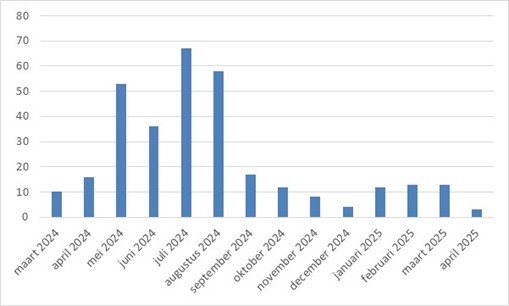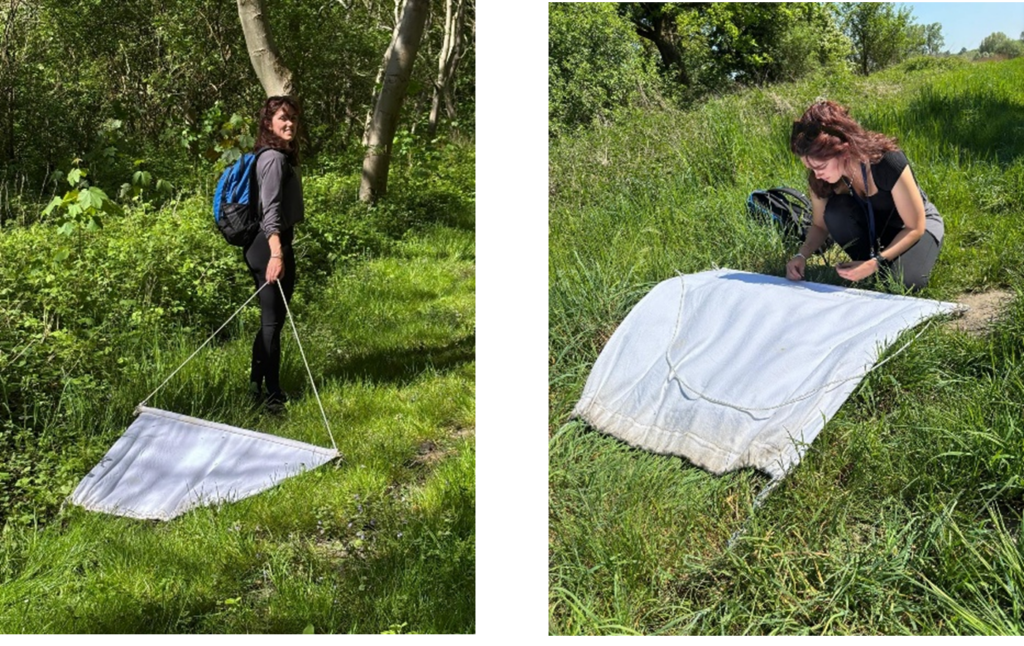

Between March 2024 and April 2025, hunters, wildlife managers, and game coordinators could submit blood samples from roe deer to the Dutch Wildlife Health Centre (DWHC). The blood samples were collected for research by the National Institute for Public Health and the Environment (RIVM) into areas where the tick-borne encephalitis virus is found in ticks. The samples could also be used for research into other diseases.
A total of 1,102 sample kits were distributed. Of these, 324 (29%) were returned; unfortunately, two of these did not have a form and were therefore unusable. Of the remaining 322, most blood samples were submitted between May 2024 and August 2024 (Figure 1).

The tick-borne encephalitis virus (TBE virus) can cause disease in humans and is primarily transmitted to humans by infected ticks. Ticks carrying the TBE virus occur in clusters, and roe deer are ideal for finding such clusters. This is because roe deer are site-faithful and have small territories, often carry ticks, and rarely become ill themselves when infected with the virus, but do produce antibodies. By testing roe deer blood for antibodies against the TBE virus, more clarity can be obtained about the areas where ticks infected with the TBE virus are present. More information about tick-borne encephalitis in humans can be found on the RIVM website (Dutch). More information about the disease in animals can be found here.
The serological testing for antibodies against tick-borne encephalitis virus was conducted using an ELISA test. A total of 312 roe deer had serological results. In 26 of these 312 deer, there was evidence of antibodies against the tick-borne encephalitis virus, or another closely related virus. Some of these positive cases were found at locations where ticks carrying the TBE virus were already known to occur, while others originated from areas where the virus had not previously been detected. If the terrain permits, targeted searches for ticks carrying the TBE virus can now be conducted at these new locations (Figure 2).

Epizootic Hemorrhagic Disease (EHD) is a disease of wild and domestic ruminants that can be transmitted by midges. This notifiable viral disease is on the rise in Europe. It has not yet been confirmed in the Netherlands, but monitoring is being intensified, and Wageningen Bioveterinary Research (WBVR) has therefore analyzed blood samples from roe deer submitted in 2024 for the presence of antibodies to the EHD virus. Read more information about EHD here.
The serological testing for antibodies to the EHD virus was performed using an ELISA test. A total of 267 roe deer from 2024 had serological results. None of these roe deer showed any evidence of antibodies to the EHD virus.
There is therefore no evidence of the presence of the EHD virus in roe deer in the Netherlands.
Bluetongue is a notifiable animal disease. In 2023 and 2024, infection with bluetongue virus serotype 3 (and to a lesser extent serotype 12) caused serious illness and mortality in sheep and cattle. Questions arose from the field about the circulating bluetongue virus and roe deer. Therefore, the WBVR analyzed the blood samples from roe deer submitted in 2024 for the presence of virus or antibodies against bluetongue. Read more information about bluetongue here.
The virological analysis of the genetic material of bluetongue virus in the blood was performed on 270 roe deer blood samples using a PCR test. The test results were negative in 267 roe deer. In the other three, the results were equivocal, meaning the test detected a signal, but it was below the cut-off value. It is then impossible to determine whether there is very little or no virus in the blood. Therefore, it is unclear whether these three roe deer were infected with bluetongue virus or not. Serological testing for antibodies against bluetongue virus was performed using an ELISA test. A total of 269 roe deer from 2024 animals had serological results. In one of these, there was evidence of antibodies against the bluetongue virus.
Roe deer therefore appear to contribute little to the spread of bluetongue virus in the Netherlands.
We would like to thank the hunters, wildlife managers, game collection coordinators and colleagues, game management units, roe deer groups, and game management units who participated in this study for their contributions.
The DWHC will provide the individual roe deer test results to the submitter. If you submitted a blood sample and haven’t received a message in October, 2025, we may have misread your email. Please email dwhc@uu.nl.